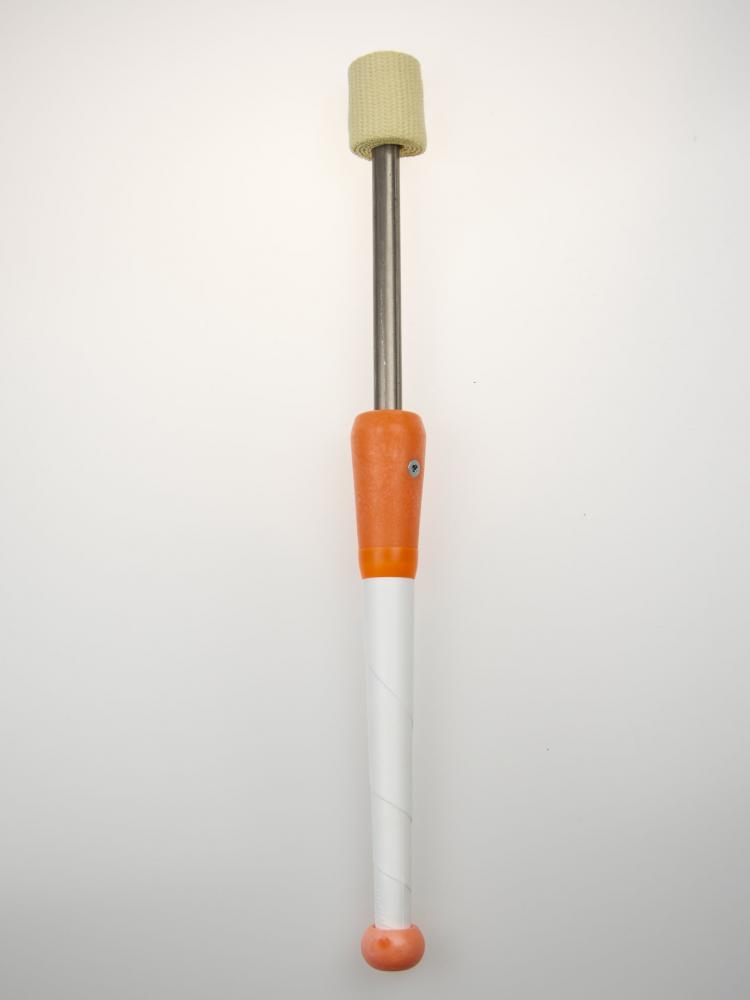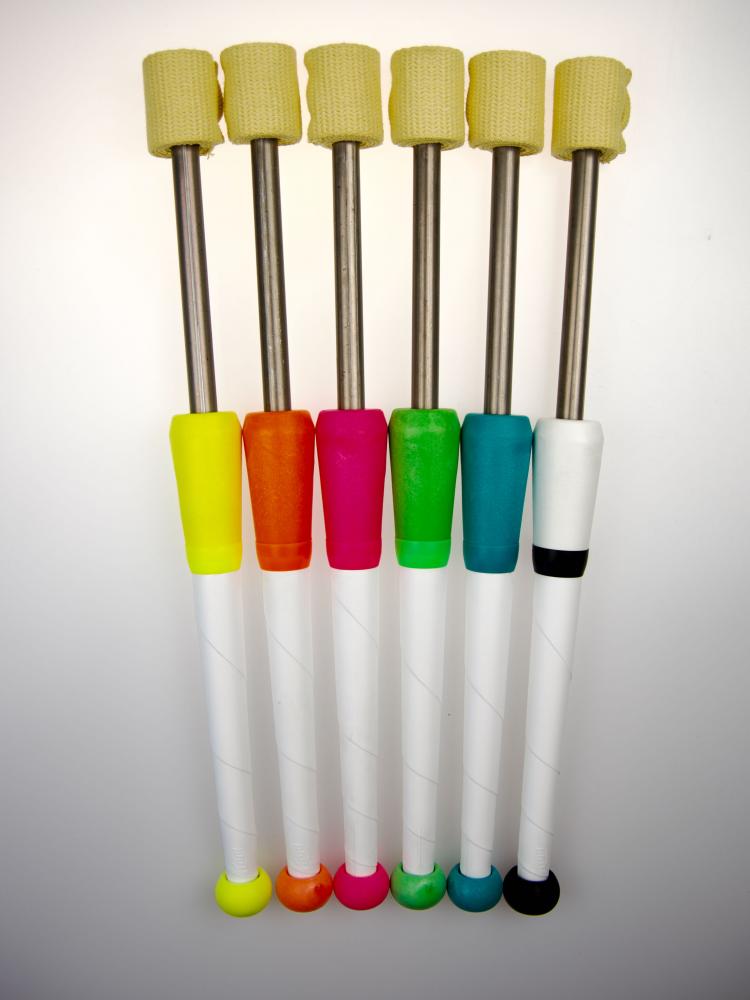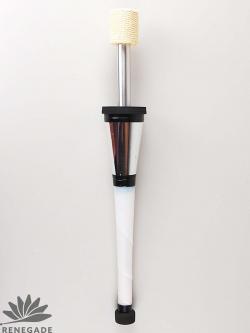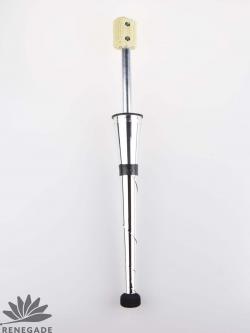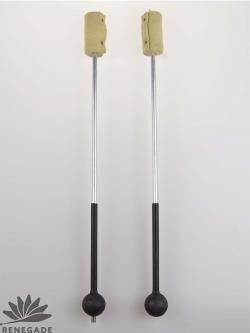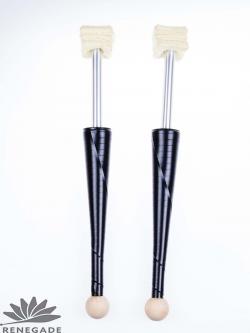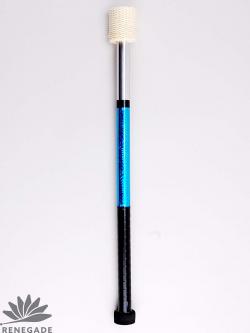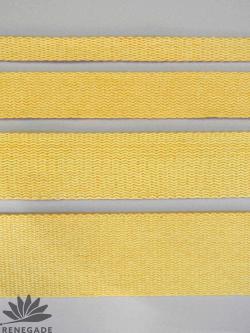Fire Juggling Torch Play ARA
A new juggling torch made by Play Juggling. Constructed using a PX4 aluminum dowel, for high durability. It comes with a 2-inch x 18-inch 100% Kevlar wick. The white handle is the same tube handle that is used for pX3, Px4 and EX1 juggling clubs. The Injection-molded center is durable and comes in a nice variety of colors.
torch weight 225 grams
length 20 inches,
wick length used to make torch head 3 X18 inches, 70mm X 5mm
tubing handle wrapped profile,
PX3 plastic dowel 5/8 diameter, aluminum sleeve
burn time 4-5 minutes with lamp oil as fuel
Juggling Torch Care and
Maintenance
Renegade Juggling torches are designed to feel just
like your clubs in both weight and handling.
All the tricks possible with clubs should transfer
over easily to your Renegade torches. In order to
keep your torches in good condition
it is very important that you follow
our recommended instructions for proper use and safety.
Fuels
There are many types fuels that can be
used on the torches. The best to use in
regards to safety and getting the maximum
life span out of your torches is lamp oil
(kerosene, paraffin or charcoal lighter).
This type of fuel is not explosively volatile
like white gas (Coleman Fuel, camp stove
fuel), and it burns at a much lower temperature.
Many jugglers prefer white gas, as it
produces a brighter flame, and lights very
quickly. It is much more dangerous than
lamp oil and reduces the life span of your
torches.
Equipment Use and
Techniques
You can either dip the torches in a
container of fuel or squirt on the fuel, (a
plastic charcoal lighter fluid bottle works
good). After applying the fuel be sure to
shake out any excess fuel from your torch
wicks before lighting them. If you do not,
the torches will spray little fire droplets off
the wicks as you juggle them. Shaking off
the excess fuel, is also important, so that the
fuel does not run down the metal sleeve and
onto the rubber gasket.
The rubber gasket in not fire proof and
must be kept away from prolonged contact
with the flames from the wick head or
another torch. Fire may come into contact
with this rubber gasket when a torch is held
in a downward orientation or when several
torches are held in one hand. If the rubber
gasket gets too hot it can melt or in extreme
cases catch on fire. If this happens blow out
the torch and let it cool before re-lighting it.
Always hold your torches upright, when not
juggling. Never leave the torch on the
ground while burning.
Do not install more than the recommended
amount of wick on the torch as this
will produce too much heat and melt or burn
the rubber torch gasket. You will increase
the life span of the wick if you always extinguish
the torch before the flame dies out.
This is because you will burn the wick
material after all the fuel is used up. Let
your torches cool off for several minutes
before refuelling and lighting again.
Safety
Obviously this is where a lot of common
sense plays in. The surface you are
juggling on should not be flammable, (dry
grass, carpet or such). You should not be
wearing highly flammable costumes or
loose polyester clothing that can easily
catch on fire. The best clothing to wear is
tight fitting 100% thick cotton or leather.
Pay particular attention to what you do
with your fuel container after you have
fueled up your torches. Never leave fuel
containers open, a dropped torch can knock
over the container and start a fire. Always
store your fuel in an appropriate container,
which is made for fuel storage.
Always have a spotter watching you
juggling fire who is paying attention and is
ready to respond to an accidental fire. They
should have a damp 100% cotton towel (fire
blanket) on hand to put out any small fires
that might occur. This damp towel is also a
good way to put out the torches if the flame
is too large to blow out. It is prudent to
rehearse safety routines and to have a code
word like ?STOP? in case the person is on
fire themselves so that the spotter can reach
the performer without getting hit by a juggling
torch. When performing swinging
torches you should also have a CO2 fire
extinguisher on hand in case of fire.
Inspect your juggling torches regularly
for any signs of wear or failure. Do not use
fire equipment that looks damaged or is in
poor repair.
Replacement wicks
Replacement wicks and other repair
parts may be purchase directly from our
website at www.renegadejuggling.com. You
will need 18 inches of 2" X 1/8" for each
torch. Remove the old wicks by cutting the
staple in half with wire cutter and remove
each leg of the staple. Tape the leading edge
of the new wick on to the torch dowel and
then tightly wrap the wick around the torch,
folding over the last half inch to making a
finished end. Temporarily tape the wick
with electrical tape to hold it while you
attach it with (2) 1 1/4 inch sheet rock
screws. You can request screws with your
replacement wick or buy this type of screw
at any hardware store. Predrill a 3/32 hole
through the folded wick edge and into the
club dowel. Screw into this pilot hole and
fully tighten so the screw head is below the
surface of the wick. Any exposed metal on
the surface of the wick will become hot and
can burn you if you catch the wrong end of
the juggling torch.
Storage and Transportation
Torches should be stored in a preferably
air tight metal container or tool box.
The torch wick may contain unburned fuel
that remains flammable. Stored torches
should not be able to come in contact with
sparks. Many commercial airlines will no
longer allow torches in checked bags that
have residue fuel on them and it is possible
that they will not be allowed on the plane.
Renegade Juggling torches are designed to feel just
like your clubs in both weight and handling.
All the tricks possible with clubs should transfer
over easily to your Renegade torches. In order to
keep your torches in good condition
it is very important that you follow
our recommended instructions for proper use and safety.
Fuels
There are many types fuels that can be
used on the torches. The best to use in
regards to safety and getting the maximum
life span out of your torches is lamp oil
(kerosene, paraffin or charcoal lighter).
This type of fuel is not explosively volatile
like white gas (Coleman Fuel, camp stove
fuel), and it burns at a much lower temperature.
Many jugglers prefer white gas, as it
produces a brighter flame, and lights very
quickly. It is much more dangerous than
lamp oil and reduces the life span of your
torches.
Equipment Use and Techniques
You can either dip the torches in a
container of fuel or squirt on the fuel, (a
plastic charcoal lighter fluid bottle works
good). After applying the fuel be sure to
shake out any excess fuel from your torch
wicks before lighting them. If you do not,
the torches will spray little fire droplets off
the wicks as you juggle them. Shaking off
the excess fuel, is also important, so that the
fuel does not run down the metal sleeve and
onto the rubber gasket.
The rubber gasket in not fire proof and
must be kept away from prolonged contact
with the flames from the wick head or
another torch. Fire may come into contact
with this rubber gasket when a torch is held
in a downward orientation or when several
torches are held in one hand. If the rubber
gasket gets too hot it can melt or in extreme
cases catch on fire. If this happens blow out
the torch and let it cool before re-lighting it.
Always hold your torches upright, when not
juggling. Never leave the torch on the
ground while burning.
Do not install more than the recommended
amount of wick on the torch as this
will produce too much heat and melt or burn
the rubber torch gasket. You will increase
the life span of the wick if you always extinguish
the torch before the flame dies out.
This is because you will burn the wick
material after all the fuel is used up. Let
your torches cool off for several minutes
before refuelling and lighting again.
Safety
Obviously this is where a lot of common
sense plays in. The surface you are
juggling on should not be flammable, (dry
grass, carpet or such). You should not be
wearing highly flammable costumes or
loose polyester clothing that can easily
catch on fire. The best clothing to wear is
tight fitting 100% thick cotton or leather.
Pay particular attention to what you do
with your fuel container after you have
fueled up your torches. Never leave fuel
containers open, a dropped torch can knock
over the container and start a fire. Always
store your fuel in an appropriate container,
which is made for fuel storage.
Always have a spotter watching you
juggling fire who is paying attention and is
ready to respond to an accidental fire. They
should have a damp 100% cotton towel (fire
blanket) on hand to put out any small fires
that might occur. This damp towel is also a
good way to put out the torches if the flame
is too large to blow out. It is prudent to
rehearse safety routines and to have a code
word like ?STOP? in case the person is on
fire themselves so that the spotter can reach
the performer without getting hit by a juggling
torch. When performing swinging
torches you should also have a CO2 fire
extinguisher on hand in case of fire.
Inspect your juggling torches regularly
for any signs of wear or failure. Do not use
fire equipment that looks damaged or is in
poor repair.
Replacement wicks
Replacement wicks and other repair
parts may be purchase directly from our
website at www.renegadejuggling.com. You
will need 18 inches of 2" X 1/8" for each
torch. Remove the old wicks by cutting the
staple in half with wire cutter and remove
each leg of the staple. Tape the leading edge
of the new wick on to the torch dowel and
then tightly wrap the wick around the torch,
folding over the last half inch to making a
finished end. Temporarily tape the wick
with electrical tape to hold it while you
attach it with (2) 1 1/4 inch sheet rock
screws. You can request screws with your
replacement wick or buy this type of screw
at any hardware store. Predrill a 3/32 hole
through the folded wick edge and into the
club dowel. Screw into this pilot hole and
fully tighten so the screw head is below the
surface of the wick. Any exposed metal on
the surface of the wick will become hot and
can burn you if you catch the wrong end of
the juggling torch.
Storage and Transportation
Torches should be stored in a preferably
air tight metal container or tool box.
The torch wick may contain unburned fuel
that remains flammable. Stored torches
should not be able to come in contact with
sparks. Many commercial airlines will no
longer allow torches in checked bags that
have residue fuel on them and it is possible
that they will not be allowed on the plane.
by Mike Gee on 02/27/21
Great!!
by Michael B. on 03/30/21
Great clubs, well balanced with nice soft handles and solid construction! Should last for years to come
by S. lopez on 06/09/22
by Sven J. on 08/18/24
I have had a set of these torches for about a year now. They are pretty good. That is to say there are things I like about them and things I don't. Pros: Love the handle because it has just the right amount of grippiness and is slender enough for flourishes. I love the lightweight. These torches will be great for juggling five torches down the line. Durability seems on par with other torches, though we shall see if they stand the test of time. My first set of torches has been going strong for over thirty years! Cons: Lightweight. These are not the best torches for especially windy conditions. Balance- I really wish play had used their longer club handles on these torches. With the shorter handles, the balance just feels a bit off. I am a little concerned about the rubber mid-section of the torch being degraded over time by exposure to the heat of the torch flames. All in all a solid juggling torch option. I really wish the balance was a bit better but these remain one of the best options on the market at the moment.

